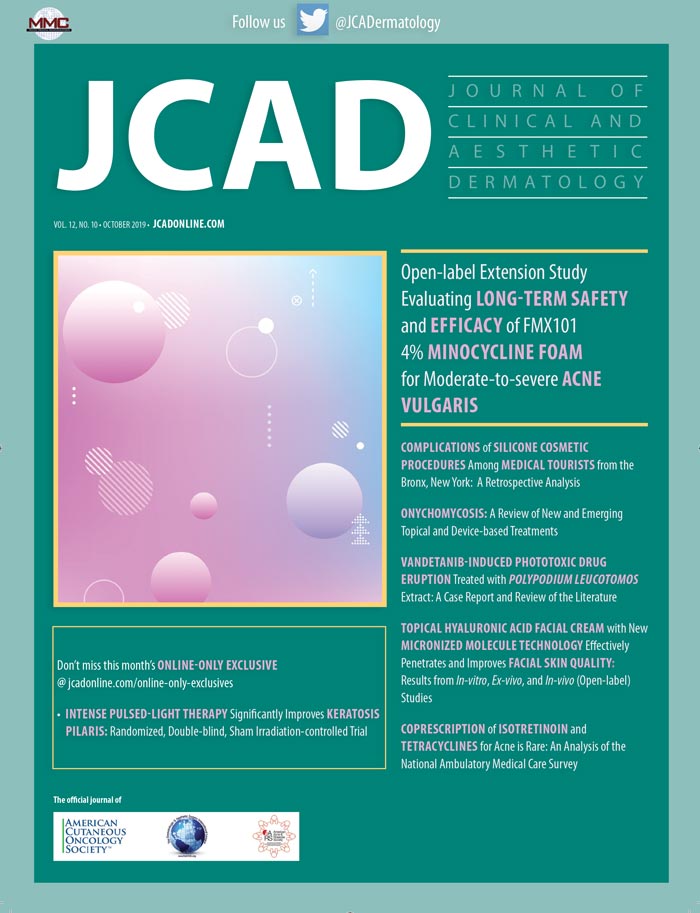VOL. 12, NO. 10 • OCTOBER 2019
 Dear Colleagues:
Dear Colleagues:
Welcome to the October 2019 issue of The Journal of Clinical and Aesthetic Dermatology. We start this issue with a study by Stein Gold et al titled, “Open-label Extension Study Evaluating Long-term Safety and Efficacy of FMX101 4% Minocycline Foam for Moderate-to-severe Acne Vulgaris.” In this extension study, eligible subjects who completed 12 weeks of double-blind treatment with FMX101 4% or vehicle in the double-blind studies (N=657) were evaluated for an additional nine months of open-label treatment with FMX101 4%. The authors reported that treatment-emergent adverse events (TEAEs) in these subjects were similar to those in the double-blind studies, with no serious TEAEs leading to discontinuation. The participants also experienced ongoing reductions in inflammatory lesions through Week 52, suggesting the safety, effectiveness, and tolerability of FMX101 4% minocycline foam for treatment of moderate-to-severe acne for up to 52 weeks.
Next, Zheng et al share the results of their study titled, “Complications of Silicone Cosmetic Procedures Among Medical Tourists from the Bronx, New York: A Retrospective Analysis.” The authors performed a retrospective chart review of patients treated at a clinic in the Bronx, New York, between the years 2008 and 2017. They identified 12 patients who developed complications following silicone procedures performed in a foreign country, Puerto Rico, or the United States by an unlicensed provider. The authors reported that these patients suffered significant morbidity following their silicone procedures, with complications including infection, implant rupture, and silicone migration. The authors concluded that clinicians should be aware of the risks for considerable and diverse morbidity following silicone injection and/or implant procedures in patients who, whether for financial, cultural, or other reasons, choose to undergo cosmetic procedures in another country or by an unlicensed practitioner in the US. The authors recommend that clinicians treat these patients with sensitivity and empathy to ensure optimal outcomes.
Following this, in a review article titled, “Onychomycosis: A Review of New and Emerging Topical and Device-based Treatments,” Kawa et al review the latest topical formulations that are approved by the United States Food and Drug Administration for treatment of onychomycosis, as well as other topical drugs that are still undergoing clinical trials. The authors also review the use of lasers in this patient population, including use of lasers as combination treatments with topical treatments.
Next, Korman et al present a case report titled, “Vandetanib-induced Phototoxic Drug Eruption Treated with Polypodium Leucotomos Extract: A Case Report and Review of the Literature.” The authors describe the case of a 55-year-old man who developed a severe, painful, erythematous, bullous eruption in sun-exposed areas of his body following initiation of vandetanib. The treatment-resistant eruption finally cleared after strict sun avoidance, discontinuation of vandetanib, and oral supplementation with Polypodium leucotomos (P. leucotomos) extract. Though the authors acknowledge that factors other than use of the P. leucotomos extract might have contributed to clearance of the eruption, they postulate that the P. leucotomos played a significant role in the patient’s recovery and has potential as a safe and effective photoprotective agent for refractory phototoxic reactions.
Then, in an original research article titled, “Topical Hyaluronic Acid Facial Cream with New Micronized Molecule Technology Effectively Penetrates and Improves Facial Skin Quality: Results from In-vitro, Ex-vivo, and In-vivo (Open-label) Studies,” Lubart et al present the results of their three-part study that assessed, using objective and subjective assessment tools, the molecule sizes, antioxidant capabilities, penetration levels, and antiaging qualities of a topical hyaluronic acid (HA) facial cream that was formulated using a new technology that micronizes HA molecules (m-HA). The authors report that their HA cream is the first of its kind to demonstrate deep penetration into the epidermal skin layer.
After this, Reserva et al present the results of their study titled, “.” Here, investigators determined the estimated frequency of the coprescription of isotretinoin and tetracyclines and assessed for trends in the use of isotretinoin and tetracycline for acne as it relates to age, sex, race, insurance, and provider specialty. The collected data, according to the authors, indicates that concomitant exposure to tetracyclines and isotretinoin is exceedingly rare, and risks associated with their concomitant use is well known among dermatologists.
Finally, don’t miss this month’s online-only article by Maitriwong et al. Here the authors present their study titled, “Intense Pulsed-light Therapy Significantly Improves Keratosis Pilaris: A Randomized, Double-blind, Sham Irradiation-controlled Trial.” The researchers evaluated the efficacy of intense pulsed light (IPL) therapy for the reduction of skin roughness, erythema, and hyperpigmentation in Thai subjects with keratosis pilaris (KP). The authors report that the IPL device used in their study demonstrated reductions in skin roughness, compared to controls, after four sessions. You can access the study by visiting jcadonline.com/online-only-exclusives/ or via the e-Edition by visiting jcad.mydigitalpublication.com/publication/?m=54680&l=1.
We hope you enjoy this issue of JCAD. As always, we welcome your feedback and submissions.
With regards,
James Q. Del Rosso, DO, FAOCD—Editor-in-Chief, Clinical Dermatology
Wm. Philip Werschler, MD, FAAD, FAACS—Editor-in-Chief, Aesthetic Dermatology
Seemal R. Desai, MD, FAAD— Associate Editor

